Looking for the best kangaroo dog food brands? Help your pup stay healthy with our wet and dry food reviews here.
Kangaroo-based dog foods are a relatively new invention in the pet food industry, but one that’s already making significant waves. The promise of a lean, healthy, environmentally-friendly meat is alluring to most dog owners. However, the world of kangaroo dog food can be a difficult one to navigate, with a lot of false promises and senselessly expensive products.
The benefits of kangaroo-based dog foods are real and measurable. With low levels of fat and high levels of crude protein, kangaroo meat is a verifiably good source of meat for dogs, particularly those who struggle with weight issues (SOURCE). Kangaroo-based dog foods are also a great solution for pups with allergies to more common meats like chicken and beef.
To help you pick a kangaroo dog food, we’ve developed a list of the very best kangaroo products on the market. Encompassing both wet and dry foods and including options suitable for both puppies and adults, our scientifically-based picks are certain to delight your dog and provide all of the nutrition that she or he needs.
Why Should You Feed Your Dog Kangaroo?
The primary reason that owners choose to feed their pups kangaroo meat is to deal with food allergies and intolerances. Kangaroo is a novel protein, which means that it’s a meat source that the large majority of dogs have never been exposed to. Dogs are far more likely to develop allergies to meats that they’ve been heavily exposed to, such as beef, lamb, and chicken, whilst novel proteins are much less likely to cause an allergic reaction (Clinical Nutrition Team, 2017).
In addition to this, kangaroo meat is one of the most environmentally friendly animal protein sources that you can buy, making it an ideal choice for dog owners who are eco-conscious. Rather than being farmed, kangaroo meat is obtained through the necessary culling of wild kangaroos. This means that precious resources like water and land aren’t wasted on farming them. Kangaroo culling is heavily regulated by the Australian government and, while some object to it, is still widely regarded as being necessary to stop kangaroo numbers reaching plague proportions (Berlin, 2020).
Is Kangaroo Good for Dogs?
Aside from being allergy and environmentally friendly, kangaroo is also a great source of nutrition for your dog. The factor that it’s most often praised for is that it’s a lean meat, meaning that it contains very little fat relative to the amount of protein. In fact, for every gram of fat, kangaroo meat contains a massive 22g of protein (Southern Game Meat, 2018). While dogs need a good amount of healthy fats, lean meat can be fantastic for pups who need to lose weight (Vets All Natural, 2019). Most kangaroo-based dog foods are also supplemented with alternative sources of healthy fats anyway, and this means that kangaroo-based foods can be great for active pups who require high amounts of protein.
Additionally, kangaroo meat is a good source of vitamins and minerals. It has particularly high levels of B-group vitamins, including vitamin B12 and B6, niacin, riboflavin, thiamine, iron, and zinc (TBAPFA, 2020). Kangaroo is also rich in omega-3 fatty acids, particularly DHA and EPA (K-Roo, 2018).
How We Chose and Ranked the Best Kangaroo Dog Foods
The first thing that we take into account when selecting high-performing dog foods is the macronutrient content. This refers to the balance of protein, fats, and carbohydrates found in a dog food product. Of the three macronutrients, protein and fats are undoubtedly the most important. Dogs need the amino acids found in protein to act as the building blocks for bodily development and need fats as a source of energy. Because of this, the American Association of Feed Control Officials dictates strict guidelines about the minimum amount of protein and fat that must be present in all dog foods sold in the U.S (AAFCO, 2014). These guidelines include the following:
- A crude protein content of over 18%
- A fat content of over 5.5%
The third macronutrient, carbohydrates, is more difficult to deal with. This is because carbohydrates aren’t actually a strictly necessary part of the canine diet (Roberts et. al., 2018). While some carb sources can be rich in vitamins and fiber, others are cheap fillers or by-products that provide calories without any real nutrition. Because of this, we developed the following rule:
- A carbohydrate content under 30% is favored, with preference given to healthy and digestible carbohydrate sources.
In addition to these general guidelines, we looked particularly closely at the calorie content of the kangaroo-based foods on this list. Because kangaroo meat is lean, it’s lower in calories. While this can be great for pups on a diet, we needed to ensure that the foods we picked were energy-dense enough to meet your dog’s energy requirements. Because of this:
- Wet foods with 90kcal/100g or higher were favored
- Dry foods with 300kcal/100g or higher were favored
Reviews of the Best Kangaroo Dog Foods
Best Wet Kangaroo Dog Foods
Our Pick
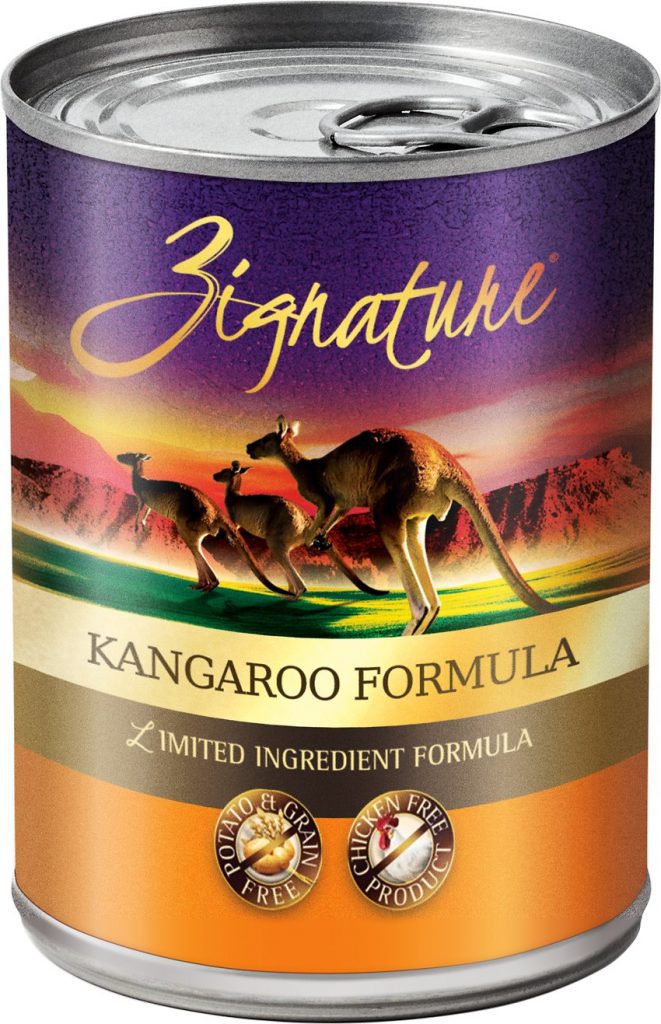
Zignature Kangaroo Formula Canned Dog Food
- Great for dogs with food allergies
- Good macronutrients
- Inexpensive – great value
Doggypedia rating: 4.5/5
First 5 Ingredients: Kangaroo, Broth, Peas, Sunflower Oil, and Carrots.
Macronutrients (Dry-Matter Basis):
Protein: 40.9% minimum
Fat: 18.2% minimum
Carbs: 27.3% maximum
zignature kangaroo
Claiming the title of the best kangaroo-based wet food is Zignature’s Kangaroo Limited Ingredient canned food. Suitable for both puppies and adult dogs, this versatile, all life stages food is a great pick for owners looking to feed their dog a kangaroo-centric diet.
The ingredient list is where this product really shines. The major meat protein source is kangaroo meat and additions like sunflower oil (high in omega-6), cranberries and blueberries (rich in anti-oxidants), and dehydrated alfalfa meal (extremely fibrous) help to inject a variety of important nutrients into the food. For dog owners who are passionate about nutrition, these ingredients are of the highest quality and are a big asset.
In terms of macronutrients, Zignature’s kangaroo formula is very impressive. It contains 40.9% protein, 18.2% fat, and 27.3% carbohydrates. The carb content is a little bit high for a wet food but is still appropriate.
Another advantage of this product is the fact that it isn’t overly expensive. Kangaroo-based foods tend to be pricey, but Zignature manages to keep their costs relatively low while still delivering a great, healthy, limited ingredient diet.
Runner-Up
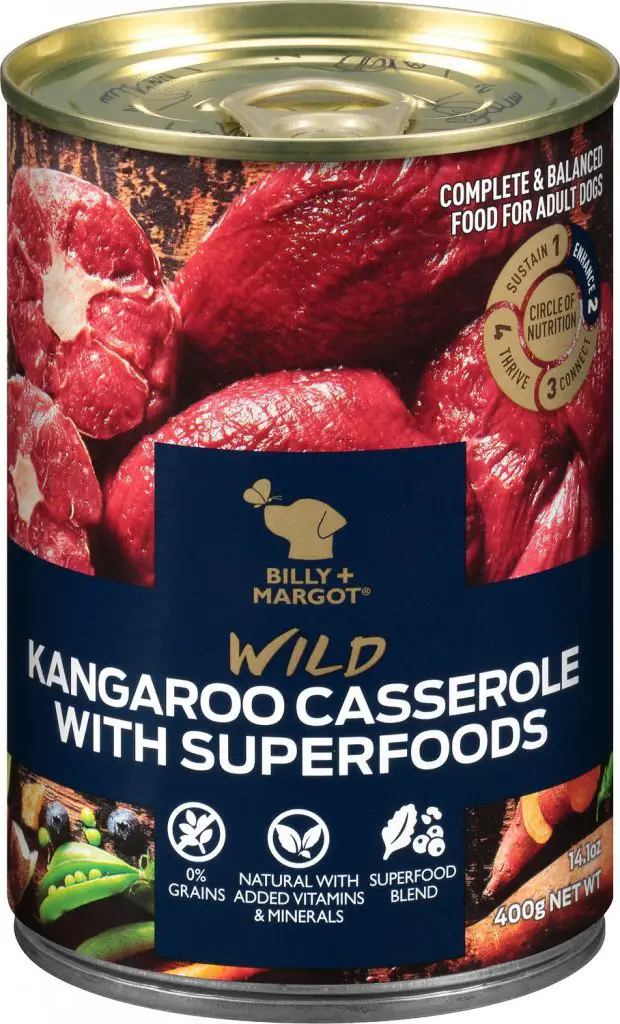
Billy + Margot Superfood Kangaroo Casserole
- Healthy, unique ingredients
- Excellent macronutrient profile
- Contains chicken and beef
Doggypedia rating: 4/5
Calories/100g 100 kCal/100g
First 5 Ingredients: Water Sufficient For Processing, Kangaroo, Chicken, Beef Liver, and Pea Flour..
Macronutrients (Dry-Matter Basis):
Protein: 41.7% minimum
Fat: 22.2% minimum
Carbs: 19.4% maximum
dog food with kangaroo meat
Taking second place in the wet food category is Billy + Margot’s Superfood Kangaroo Casserole. With a good macronutrient balance and some interesting inclusions to the ingredient list, this grain-free food is a solid pick for any kangaroo-loving pup.
In line with its title as a ‘superfood’ product, this dog food has some interesting, novel ingredients. These include flaxseed oil, inulin (prebiotic fiber), coconut oil, and blueberries. Unlike many superfood products, each of these ingredients has a distinct and proven benefit, packing this product full of omega-3 fatty acids, vitamins, minerals, and fiber. Some may be alarmed by the fact that the first ingredient is water, but this is fairly standard and just means that the food has a gravy-like consistency.
In terms of macronutrients, Billy + Margot’s wet food is arguably the best product on this list. It contains 41.7% protein, 22.2% fat, and just 19.4% carbohydrates. This balance is typical of a high-quality food and the high protein content is particularly impressive.
The major downside of this product is the fact that it contains chicken and beef liver in addition to kangaroo. This means that it isn’t suitable for dogs that have common food allergies. The ‘caramel color’ included on the ingredient list is also a potential concern, as certain colorants have been linked to cancer-causing compounds (CSPI, 2011).
Best Dry Kangaroo Dog Foods:
Our Dry Pick
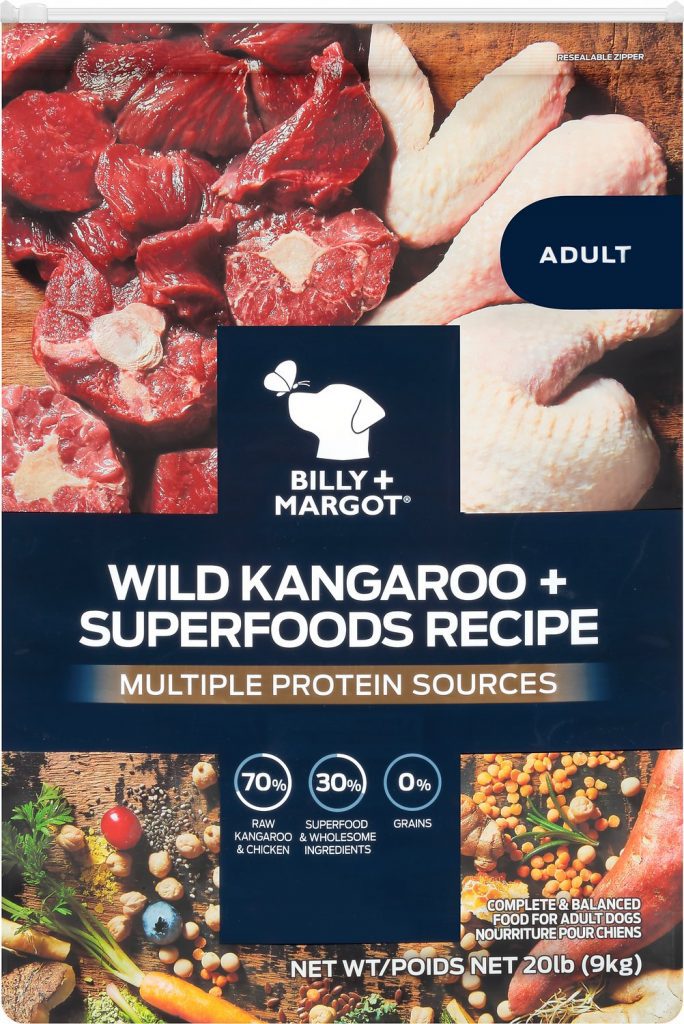
Billy + Margot Superfood Blend
- Unique ingredient list
- Good macronutrient balance
- Expensive
Doggypedia rating: 4/5
Calories/100g 335 kCal/100g
First 5 Ingredients: Kangaroo, Chicken, Whole Field Peas, Red Lentils, and Sweet Potato..
Macronutrients (Dry-Matter Basis):
Protein: 37.8% minimum
Fat: 13.3% minimum
Carbs: 40% maximum
kangaroo diet for dogs
Claiming first place in the dry food category is Billy + Margot’s Superfood blend. With a strong ingredient list, good macronutrient balance, and appropriate energy density, this food is a great pick for dog owners looking for a kangaroo-based kibble for their pup.
The main stand-out of this recipe is the novel ingredients that it includes. Kale, spinach, pumpkin, blueberries, cranberries, chia seeds, and ginger root all make an appearance. These foods are packed with a variety of different nutrients that means your dog will be getting all of the vitamins, minerals, and fiber that she or he needs.
In terms of macronutrients, Billy + Margot does very well. While most kangaroo-based dog foods have an excess of carbohydrates, Superfood Blend manages to avoid this. It contains 40% carbohydrates, which is very reasonable given that the major carb sources are all healthy. The protein content, 37.8%, is also impressive and the fat content, 13.3%, reflects the lean nature of kangaroo meat. The energy density of this product is 335 kcal/100g, which is high enough to fulfill your dog’s energy requirements.
Some potential downsides to this product are the fact that it includes chicken, which means that it may not suit some allergy-prone dogs, and its price. Kangaroo dog foods are typically more expensive than traditional products, but even taking this into account Billy + Margot’s Superfood Blend is on the pricier side.
Also Great
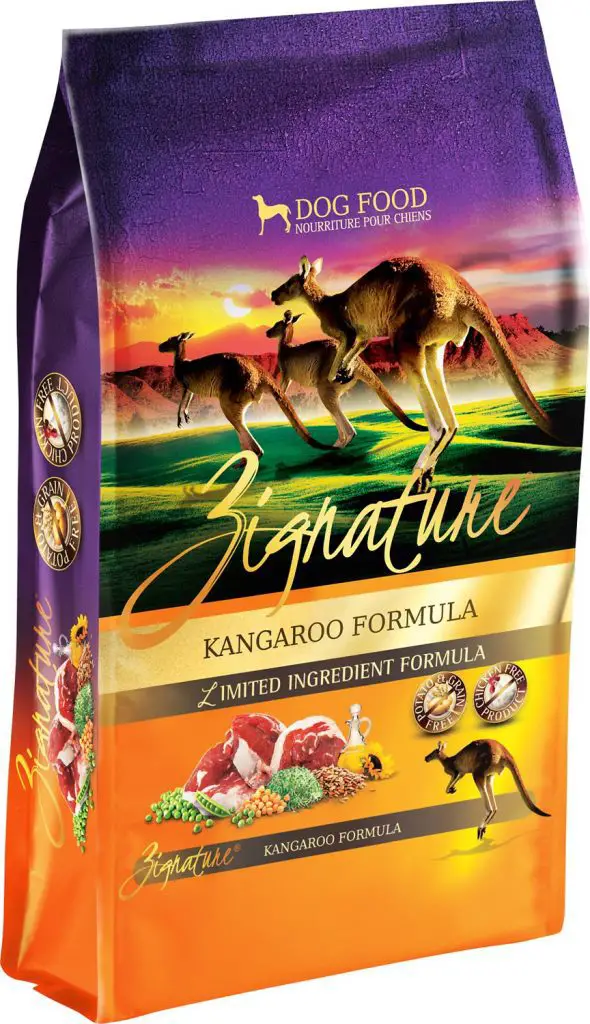
Zignature Kangaroo Dry Food
- Trusted brand
- Short ingredient list
- High carbohydrate content
Doggypedia rating: 4/5
Calories/100g 387 kCal/100g
First 5 Ingredients: Kangaroo, Kangaroo Meal, Peas, Chickpeas, and Pea Flour.
Macronutrients (Dry-Matter Basis):
Protein: 28.9% minimum
Fat: 15.6% minimum
Carbs: 46.7% maximum
Next in the dry food section is Zignature’s Kangaroo Dry Food. A reputable and well-known brand, Zignature’s kangaroo-based kibble is a good pick for those owners looking for a food to combat their pup’s food allergies with a limited ingredient formula.
Unlike Billy + Margot’s Superfood blend, the only meat source in Zignature’s dry dog food is kangaroo. For dog owners looking for a limited ingredient, novel protein diet to alleviate their pooch’s food allergies, this is a huge plus. In addition to this, the ingredient list is fairly brief. On top of kangaroo and various veggies, the only other ingredients are supplements like folic acid, vitamin A, biotin, choline chloride, and calcium iodate. This means that dogs with multiple food allergies are more likely to be able to tolerate this food.
Zignature’s macronutrient balance fulfills AAFCO’s requirements, with 28.9% protein and 15.6% fat. The carbohydrate content, however, is on the high side. Sitting at 46.7%, it indicates that the balance of meat and carb sources should be tipped more heavily towards the meat end. However, the carb sources are relatively healthy, including ingredients like green lentils, chickpeas, and flaxseed. Because of this, the product is still verifiably nutritious and healthy.
Runner Up
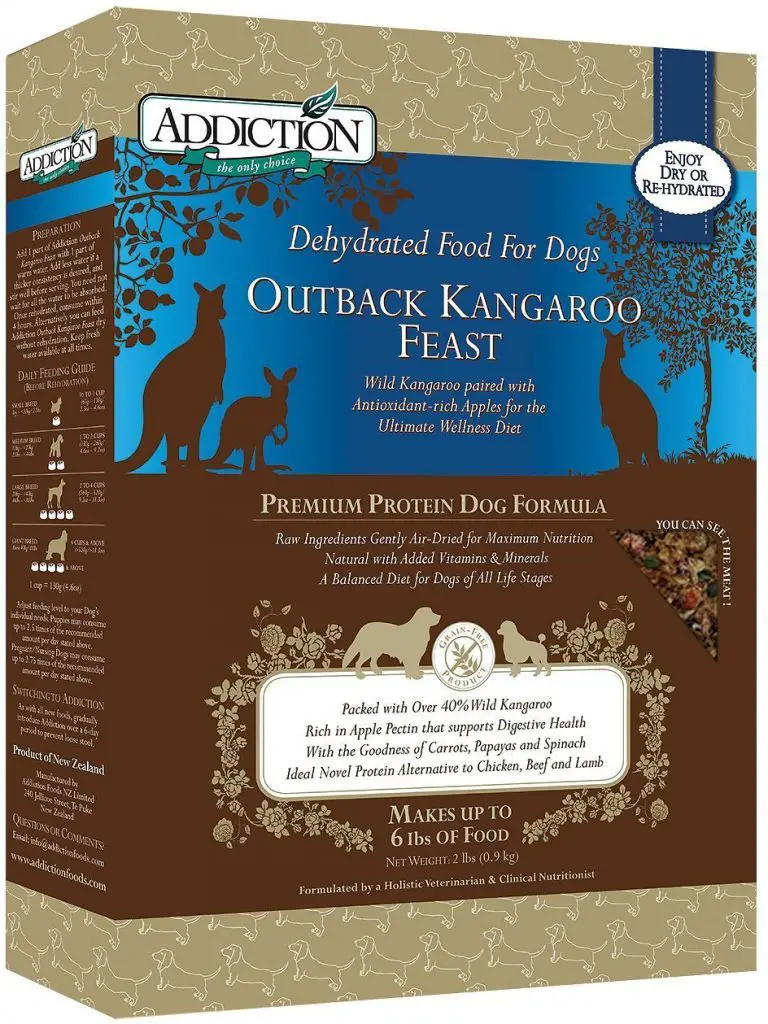
Addiction Outback Kangaroo Feast
- Raw, dehydrated recipe
- High in carbohydrates
- Expensive
Doggypedia rating: 3/5
Calories/100g 370 kCal/100g
First 5 Ingredients: Kangaroo, Potatoes, Carrots, Canola Oil, and Tapioca.
Macronutrients (Dry-Matter Basis):
Protein: 23.9% minimum
Fat: 11.4% minimum
Carbs: 55.7% maximum
Next is a unique kind of kangaroo dog food: Addiction’s Outback Kangaroo Feast. Made in New Zealand, this product is a raw dog food, meaning that many nutrients that are usually lost during the cooking process are still present in this food. However, there are also some significant downsides to this food that means it places last in the dry food category.
Outback Kangaroo Feast is a dehydrated product, meaning that owners simply need to add water to the dry powder and then serve. This is great for pups who prefer a wet consistency to their food and for owners who want a food that won’t expire within a few weeks. However, this extra step of preparation can be a hassle for busy pet owners.
In terms of macronutrients, Outback Kangaroo does reasonably well. On a dry-matter basis, it contains 23.9% protein and 11.4% fat, which means that it complies with AAFCO recommendations. However, the carbohydrate content is very high. Sitting at 55.7%, this percentage indicates that the food should contain a much higher proportion of kangaroo meat than it really does.
Another downside to this product is the expense. Addiction indicates that a 2-lb box of powder will make up to 6-lbs of food, but even taking this into consideration, this product is by far the most expensive on this list.
Read More Dog Food Reviews: Best Dry Dog Food or Best Boxer Dog Food
SOURCES:
- Novel Protein Diets: Clinical Nutrition Team, (2017). What every pet owner should know about food allergies. [online] Clinical Nutrition Service at Cummings School. Available at: https://vetnutrition.tufts.edu/2017/01/food-allergies/
- Kangaroo Meat Nutrient Profile: Sgm.com.au. (2018). Nutrition and heart health aspects of kangaroo meat. [online] Available at: https://www.sgm.com.au/html/nutrition.html [Accessed 1 Feb. 2020].
- Kangaroo for Weight Loss: Vets All Natural. (2019). Weight Loss for Dogs and Cats – Vets All Natural. [online] Available at: https://vetsallnatural.com.au/weight-loss-for-dogs-cats/ [Accessed 2 Feb. 2020].
- Kangaroo Culling: Berlin, J. (2020). Australia’s beloved kangaroos are now controversial pests. [online] Nationalgeographic.com. Available at: https://www.nationalgeographic.com/magazine/2019/02/australia-kangaroo-beloved-symbol-becomes-pest/ [Accessed 1 Feb. 2020].
- Vitamin Content of Kangaroo Meat: The Biologically Appropriate Pet Food Association. (2020). Kangaroo Nutritional Profile. [online] Available at: https://www.biologicallyappropriate.com/pages/kangaroo-nutritional-profile [Accessed 2 Feb. 2020].
- Omega-3 in Kangaroo Meat: K-ROO. (2020). K-ROO Kangaroo Meat Nutrition. [online] Available at: http://k-roo.com.au/nutrition/ [Accessed 2 Feb. 2020].
- AAFCO 2014 Recommendations: The 2014 AAFCO Dog Food Nutrient Profile for Growth and Reproduction. (2019). [ebook] AAFCO. Available at: https://www.aafco.org/Portals/0/SiteContent/Regulatory/Committees/Pet-Food/Reports/Pet_Food_Report_2013_Midyear-Proposed_Revisions_to_AAFCO_Nutrient_Profiles.pdf [Accessed 1st Feb. 2020].
- Optimal carbohydrate content in dog food: Roberts, MT, Bermingham, EN, Cave, NJ, Young, W, McKenzie, CM, Thomas, DG. Macronutrient intake of dogs, self‐selecting diets varying in composition offered ad libitum. J Anim Physiol Anim Nutr. 2018; 102: 568– 575. https://doi.org/10.1111/jpn.12794
- Carcinogenicity of ‘caramel color:’ CSPI (2011). FDA Urged to Prohibit Carcinogenic “Caramel Coloring” | Center for Science in the Public Interest. [online] Cspinet.org. Available at: https://cspinet.org/new/201102161.html [Accessed 4 Feb. 2020].
